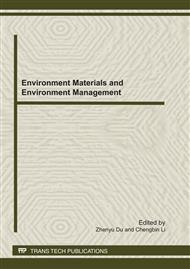p.78
p.84
p.90
p.96
p.101
p.106
p.110
p.113
p.117
Enhanced Nitrogen Removal of Low C/N Wastewater in a Subsequent Denitrifying Reactor Fed by Endogenous Carbon Source Generated from Primary Sludge Fermentation
Abstract:
A novel post-denitrification system fed by carbon source from primary sludge (PS) was used for enhancing biological nitrogen removal (BNR) of low C/N wastewater. This system included one anoxic/oxic (AO) reactor and a special reactor for simultaneous sludge fermentation and denitrification (Sifeden). Ammonia was nitrified to nitrate in AO and then the nitrate was reduced to dinitrogen in Sifeden , into which PS was added intermittently. Results showed that this system had high performance on nitrogen removal. Total nitrogen (TN) removal efficiency was higher than 85% and the effluent TN≤10mg/L in the condition of influent C/N≤2. In Sifeden, volatile fatty acid (VFA) produced from PS fermentation provided electron donor for nitrate reduction, and PS was preliminarily stabilized simultaneously. Oxidation-Reduction Potential (ORP) had a significant correlation with the denitrification performance. TN removal efficiency could be further improved if adopting proper PS addition strategy according to the ORP profiles.
Info:
Periodical:
Pages:
101-105
Citation:
Online since:
July 2011
Authors:
Keywords:
Price:
Сopyright:
© 2011 Trans Tech Publications Ltd. All Rights Reserved
Share:
Citation:


